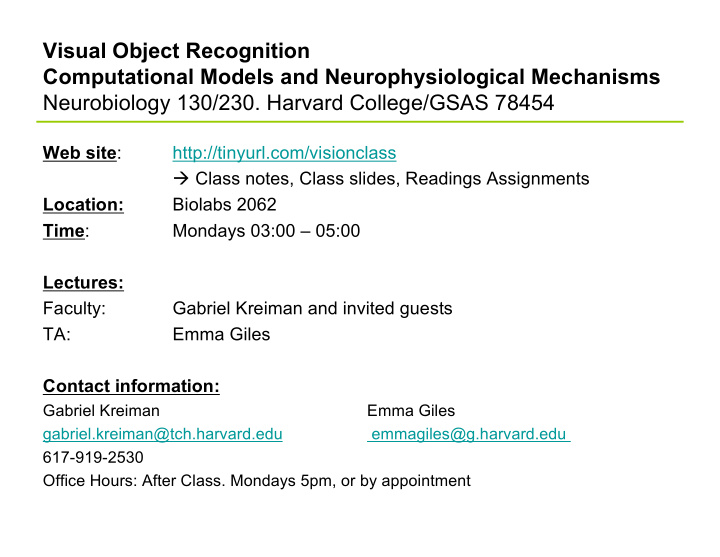



Visual Object Recognition Computational Models and Neurophysiological Mechanisms Neurobiology 130/230. Harvard College/GSAS 78454 Web site : http://tinyurl.com/visionclass à Class notes, Class slides, Readings Assignments Location: Biolabs 2062 Time : Mondays 03:00 – 05:00 Lectures: Faculty: Gabriel Kreiman and invited guests TA: Emma Giles Contact information: Gabriel Kreiman Emma Giles gabriel.kreiman@tch.harvard.edu emmagiles@g.harvard.edu 617-919-2530 Office Hours: After Class. Mondays 5pm, or by appointment
Visual Object Recognition Computational Models and Neurophysiological Mechanisms Neurobiology 130/230. Harvard College/GSAS 78454 GRADING Class participation 15% Comments on class notes* 15% Homework* 50% Final paper* 20% Reading assignments. [60% of grade] One paper per class. Total of 11 reading assignments
Visual Object Recognition Computational Models and Neurophysiological Mechanisms Neurobiology 130/230. Harvard College/GSAS 78454 GRADING. Comments on class notes* 15% Lecture notes available at: klab.tch.harvard.edu/academia/classes/Neuro230/2018/Neuro_130_230_Notes_2018.html Maximum grade per week = 10 points. Spelling/grammar/wrong citation/wrong figure reference/etc: 1 point Undefined word in text, undefined variable in equation: 2 points Error in equation: 5 points Erroneous statement: 5 points Suggestion for figure improvement: 4 points Specific clarification question: 3 points Relevant work missing in notes: 3 points Filename: <YOURNAME>_LECTURE<LECTURENUMBER>_COMMENTS Format: PDF, Word, Text, Latex Lecture number, line number, your comments/edits Due date: Monday, day of the lecture at midnight. By email: emmagiles@g.harvard.edu
Visual Object Recognition Computational Models and Neurophysiological Mechanisms Neurobiology 130/230. Harvard College/GSAS 78454 GRADING. Homework* 50% One reading assignment per class. Original scientific literature Total of 11 reading assignments Write two paragraphs about the paper: Paragraph 1: Discuss one missing control or one problem with the interpretation. Paragraph 2: Discuss a logical follow-up question. Note: Do NOT copy and paste the paper. We have already read it. Filename: <YOURNAME>_Assignment<AssignmentNumber> Format: PDF, Word, Text, Latex Due date: One week after assignment discussion in class. Monday, midnight. See specific dates on website. By email: emmagiles@g.harvard.edu
Visual Object Recognition Computational Models and Neurophysiological Mechanisms Neurobiology 230. Harvard College/GSAS 78454 Class 1 [09/10/2018]. Introduction to pattern recognition [Kreiman] Class 2 [09/17/2018]. Why is vision difficult? Natural image statistics. The retina. [Kreiman] Class 3 [09/24/2018]. Lesions and neurological studies [Kreiman]. Class 4 [10/01/2018]. Psychophysics of visual object recognition [Sarit Szpiro] October 8: University Holiday Class 5 [10/15/2018]. Primary visual cortex [Hartmann] Class 6 [10/22/2018]. Adventures into terra incognita [Frederico Azevedo] Class 7 [10/29/2018]. High-level visual cognition [Diego Mendoza-Haliday] Class 8 [11/05/2018]. Correlation and causality. Electrical stimulation in visual cortex [Kreiman] Class 9 [11/12/2018]. Visual consciousness [Kreiman] Class 10 [11/19/2018]. Computational models of neurons and neural networks. [Kreiman] Class 11 [11/26/2018]. Computer vision. Artificial Intelligence in Visual Cognition [Bill Lotter] Class 12 [12/03/2018]. The operating system for vision. [Xavier Boix] FINAL EXAM, PAPER DUE 12/13/2018. No extensions.
Visual Object Recognition Computational Models and Neurophysiological Mechanisms Neurobiology 230. Harvard College/GSAS 78454 Recommended books Suggested Books Ullman S (1996) High-level vision. MIT Press. Wandell BA (1995) Foundations of vision. Sunderland Sinauer Associates. Chalupa LM and Werner JS (editors) (2003). The Visual Neurosciences. MIT Press. Frisby and Stone (2010). Seeing. MIT Press. Kriegeskorte and Kreiman (2011). Visual population codes. MIT Press. Other good books Purves and Lotto. (2003). Why we see what we do. Sinauer Books. Deco and Rolls (2004). Computational Neuroscience of Vision. Oxford University Press. Ripley. Pattern recognition and neural networks (1996). Cambridge University Press. Rao, Olshausen and Lewicki (eds) (2002). Probabilistic models of the brain. MIT Press. Koch C (2005) The quest for consciousness. Roberts & Company Publishers. Regan (2000) Human perception of objects. Sinauer Books. Dayan and Abbott (2002). Theoretical Neuroscience. MIT Press.
Academic Integrity Policy All reading assignments will be discussed in class. During class, collaboration and discussion is not only permitted but actually encouraged. After class, each student must prepare the homework on his/her own. Students should be aware that in this course collaboration of any sort on any work submitted for formal evaluation is not permitted. This means that you may not discuss your problem sets, paper assignments, exams, or any other assignments with other students. All work should be entirely your own. The use of textbooks, books and articles is encouraged. Students must use appropriate citation practices to acknowledge the use of books, articles, websites or lectures, that were consulted to complete your assignments.
Reading Assignment 1 Olshausen, B. A. & Field, D. J. Emergence of simple- cell receptive field properties by learning a sparse code for natural images. Nature 381, 607-609 (1996). Discussion: Monday 09/17 Reading assignment due: Monday 09/24 Reading Assignments Link
Recommend
More recommend